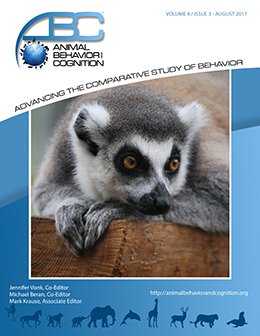Vol 4, Issue 3, August 2017
Preliminary Study to Investigate the Delboeuf Illusion in Ring-tailed Lemurs (Lemur catta): Methodological Challenges
Citation
Santacà, M., Regaiolli, B., Miletto Petrazzini, M. E., Spiezio, C. & Agrillo, C. (2017). Preliminary study to investigate the Delboeuf illusion in ring-tailed lemurs (Lemur catta): Methodological Challenges. Animal Behavior and Cognition, 4(3), 365-377. https://doi.org/10.26451/abc.04.03.13.2017
Abstract
Visual illusions are commonly used in animal cognition studies to compare visual perception among vertebrates. To date, researchers have focused their attention mainly on birds and mammals, especially apes and monkeys, but no study has investigated sensitivity to visual illusions in prosimians. Here we investigated whether lemurs (Lemur catta) perceive the Delboeuf illusion, a well-known illusion that occurs when subjects misperceive the relative size of an item because of its surrounding context. In particular, we adopted the spontaneous preference paradigm used in chimpanzees and observed lemurs’ ability to select the larger amount of food. In control trials, we presented two different amounts of food on two identical plates. In test trials, we presented equal food portion sizes on two plates differing in size: If lemurs were sensitive to the illusion, they were expected to select the food portion presented on the smaller plate. In control trials, they exhibited poor performance compared to other mammals previously observed, being able to discriminate between the two quantities only in the presence of a 0.47 ratio. This result prevented us from drawing any conclusion regarding the subjects’ susceptibility to the Delboeuf illusion. In test trials with the illusory pattern, however, the subjects’ choices did not differ from chance. Our data suggest that the present paradigm is not optimal for testing the perception of the Delboeuf illusion in lemurs and highlight the importance of using different methodological approaches to assess the perceptual mechanisms underlying size discrimination among vertebrates.
